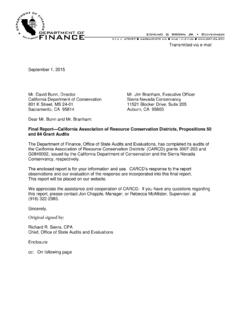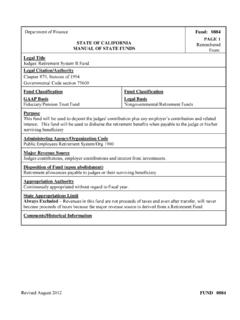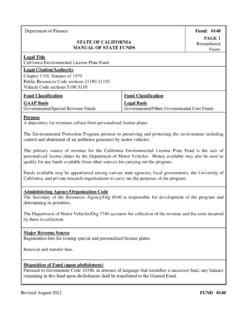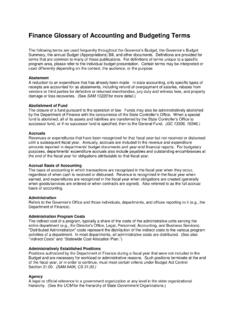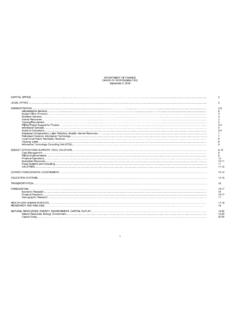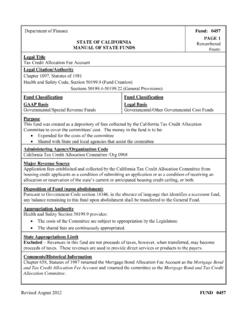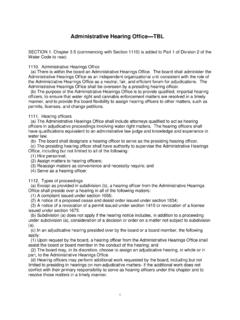Transcription of California Department of Food and Agriculture 1220 N St ...
1 MACRO USED: H:\Prod\Template\ Lindsay Rains California Department of food and Agriculture 1220 N St. Sacramento, CA 95814 February 17, 2017 Dear Ms. Rains: Thank you for submitting the standardized regulatory impact assessment (SRIA) and the summary (Form DF-131) for the proposed Medical Cannabis regulations, as required in California Code of Regulations, title 1, section 2002(a)(1). As proposed regulations were not submitted with the SRIA, these comments are based on the SRIA and our understanding of Proposition 64, and the Medical Marijuana Regulation and Safety Act of 2015. The proposed regulations will set forth the conditions for cultivators to be licensed by the state, with 12 different license types based on growing conditions and size, and another two license types for nurseries or processing firms.
2 To receive a state license, applicants would have to receive local licenses; must comply with all relevant water, environmental, and labor laws; submit cultivation plans; and pay the application fees. The estimated cost of compliance per applicant ranges from $4 per pound for nurseries to $248 per pound for small outdoor cultivators. While this will raise the costs for compliant cultivators, this can be counterbalanced by a reduction in the risk of being fined or shut down by state and local government. The overall effect will be to increase the farm-gate price from $1,500 to $1,590, and to decrease the production of medical cannabis from 250,000 to 230,000 pounds, partially as a result of some consumers moving to the adult use market.
3 The medical cannabis segment should remain a small fraction of the estimated million pounds produced in California on an annual basis. The total costs of compliance to the California economy would add up to around $70 million in calendar year 2018, the first full year of the regulations. Finance generally concurs with the methodology used to estimate the annual economic impact under the proposed regulation. The analysis does a good job of laying out the underlying mechanisms of how the regulations will affect the economy. This SRIA is unusual in that the baseline must incorporate the legalization of adult use, despite the fact that the regulations for that will come into effect at the same time as the medical cannabis regulations.
4 In these and other areas, such as the assumptions that federal policy will be unchanged or that compliant cultivators will be motivated to report on non-compliant competitors, the SRIA is clear about underlying assumptions. However, there are three areas where the analysis must be augmented. First, the SRIA must include an estimate of the local revenue increases from the state regulating medical cannabis. While collecting fees at the local level is not under the control of the state, there will be other impacts from excise fees. The SRIA does a good job of including local fees and enforcement in the discussion of cultivator incentives, and it would aid the reader to have the local government side laid out in parallel, both the impacts due to the regulation (as required), and the assumed impacts from local government choices.
5 Second, the assumptions regarding other state agency costs must be included in the SRIA. Finally, the model omits the third option for cultivators to comply only with (unknown) adult use future regulations, as the model assumes that the choice by cultivators is between complying with the proposed regulations or remaining illegal. To the extent that medical cannabis regulations are geared towards maximum safety, adult use regulations may be less stringent and more attractive from a compliance standpoint. We appreciate the efforts you made to contact affected stakeholders, and to gather information about the costs, benefits, and market conditions in the cannabis industry. We also appreciate the willingness of the agency in engaging us early in the SRIA process.
6 These comments are intended to provide sufficient guidance outline prospective revisions to the SRIA. The SRIA, a summary of Finance s comments, and any responses must be included in the rulemaking file that is available for public comment. Finance understands that the proposed regulations may change during the rulemaking process. If any significant changes to the proposed regulations result in economic impacts not discussed in the SRIA, please note that the revised economic impacts must be reflected on the Standard Form 399 for the rulemaking file submittal to the Office of Administrative Law. Please let us know if you have any questions regarding our comments. Sincerely, Irena Asmundson Chief Economist Department of Finance cc: Ms.
7 Panorea Avdis, Director, Governor s Office on Business and Development Ms. Debra Cornez, Director, Office of Administrative Law Mr. Kevin Masuhara, Deputy Secretary, Department of food and Agriculture Ms. Amber Morris, CalCannabis Branch Chief, Department of food and Agriculture Mr. Duncan MacEwan, ERA Economics, LLC

